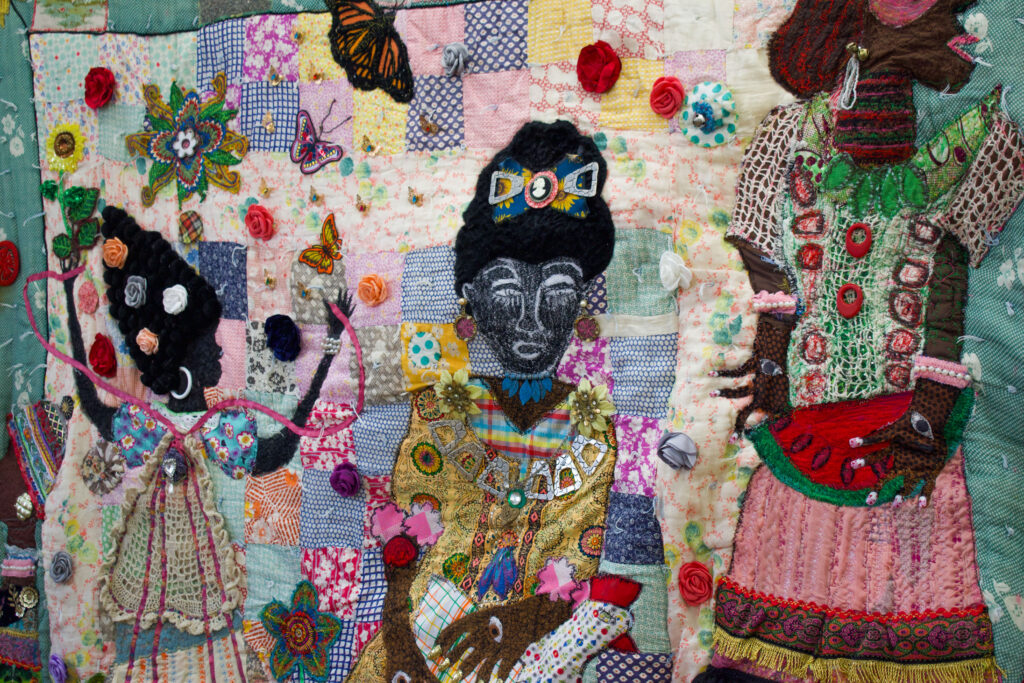Wisconsin’s largest city and home of the Bucks and Brewers, Milwaukee is typically associated with its robust sports culture.
However, Milwaukee’s art scene is bustling and rivals those of bigger cities like New York or Chicago.
It’s unique because people are supported for being themselves, no matter what their background is, local artists say. And individuals who want to change push new boundaries and create pathways for new artists.
As Tony Nickalls, the owner of Aquae Nguvu Gallery and Studio in Milwaukee’s Historic Third Ward says, “I use the word supportive,” to describe the city’s art scene.

Neto Atkinson
Neto Atkinson is an art therapist and artist from Antigua, Guatemala.
Atkinson practiced social work in Guatemala, where he worked with people who had suffered various forms of human trafficking. Atkinson was faced with people who could not speak due to their past experiences, so he used forms of art and music as a way for people to express themselves — through dancing or on paper — without having to speak.
After multiple death threats for his anti-human trafficking efforts, he went to school in Chicago for a master’s degree in art therapy and later settled in Milwaukee.
He is currently the only bilingual art therapist in the Milwaukee area.
Atkinson’s goals are simple, yet they do not fit into the classic mold of an artist.
“I am an art therapist, and I’m also a licensed professional counselor,” Atkinson says. “And the other part of my life, I am also a painter and artist, and I utilize art to heal myself and to teach others how to explore themselves through the creative process.”
Atkinson prides himself on having art that inspires positivity and inclusivity.
Other people see this desire, too.
“His desire for community and unity and inclusion, and all of those really nice words that just mean, what we can do together without any bias or judgment or any of those negative words,” says Daniela Weber, the manager for his Milwaukee art museum, The Catacombs of Neto (Las Catacumbas de Neto). “Let’s create, let’s share, let’s live and love kind.”
With his art, Atkinson wants to bring people together, no matter the color, race, religion or background.
“My goal, not only as an artist, but as an art therapist, is to create a more beautiful and more colorful society. “
“My favorite color is the color of the rainbow, because one, no color can exist, one without the other,” Atkinson says, recounting a quote that’s inspiring to him.
He actively engages in Hispanic community outreach.
One of the ways Atkinson does this is by having his art explained in Spanish and English. He does this to reach members of the Spanish-speaking community, making sure they feel comfortable, but also to target English speakers, bringing the two groups together.
“Anywhere you look on each side of the door, on every single artist statement, any time we have a party and he gives a speech, he goes back and forth saying it both in English and in Spanish,” Weber says.
Atkinson’s work is full of vibrant colors and features many different styles. He creates not just because he enjoys it, but instead to connect and bring people together through art, bringing only positive energy to others. Atkinson fights for a society where everyone is equal.
“My goal, not only as an artist, but as an art therapist, is to create a more beautiful and more colorful society,” Atkinson says.

Debra Brehmer’s gallery features toilets depicted on various forms of fabric. Photo by Andrea Brehovska.
Debra Brehmer
Debra Brehmer is a journalist-turned-art gallery owner. Throughout her diverse career, she has always chosen to focus on uplifting minority groups.
“I think I just naturally gravitated toward the more marginalized populations,” Brehmer says. “And you know, who’s been left out of the conversation, who isn’t in the history books, who and why?”
Brehmer’s focus on the underdog fueled the creation of a book and art gallery featuring art from various incarcerated individuals from Wisconsin.
The project started during COVID-19 when Brehmer, who owns the commercial gallery Portrait Society Gallery, represented an artist, M. Winston, who made small paintings while incarcerated.
This interaction inspired Brehmer and Paul Salsieder, the manager of her gallery to take the idea further.

They got in touch with Shannon Ross, who was incarcerated himself and now works to help other formerly incarcerated people reintegrate into life outside prison through his nonprofit, The Community. Ross put them in touch with other incarcerated artists.
Over time, they got in contact with all of the state’s 36 prisons and institutions. They created a book, “Against All the Odds,” featuring the work of five incarcerated and 60 previously incarcerated artists, giving them a chance to showcase their work to people outside of the prison system, something they might have otherwise never had the chance to do.
The two also created an art gallery to display these works. The first exhibition was at the Milwaukee Institute of Art and Design in early 2023. Once it ended, the exhibit traveled to other galleries across the state.
Back when the art gallery was first opened in Milwaukee, it skyrocketed in popularity and attracted a new audience.
“I’ve never, ever seen anything like this. It was insane. It was packed. There were probably 1,000 people who attended that opening,” Brehmer says.
With the exhibit, people on the outside saw those who are incarcerated as more than their conviction status, Brehmer says. Instead, they showcased their true human essence and were admired for their art.
Cover Photo: A sequined quilt from Debra Brehmer’s gallery. Photo by Andrea Brehovska.
Published Dec. 9, 2024